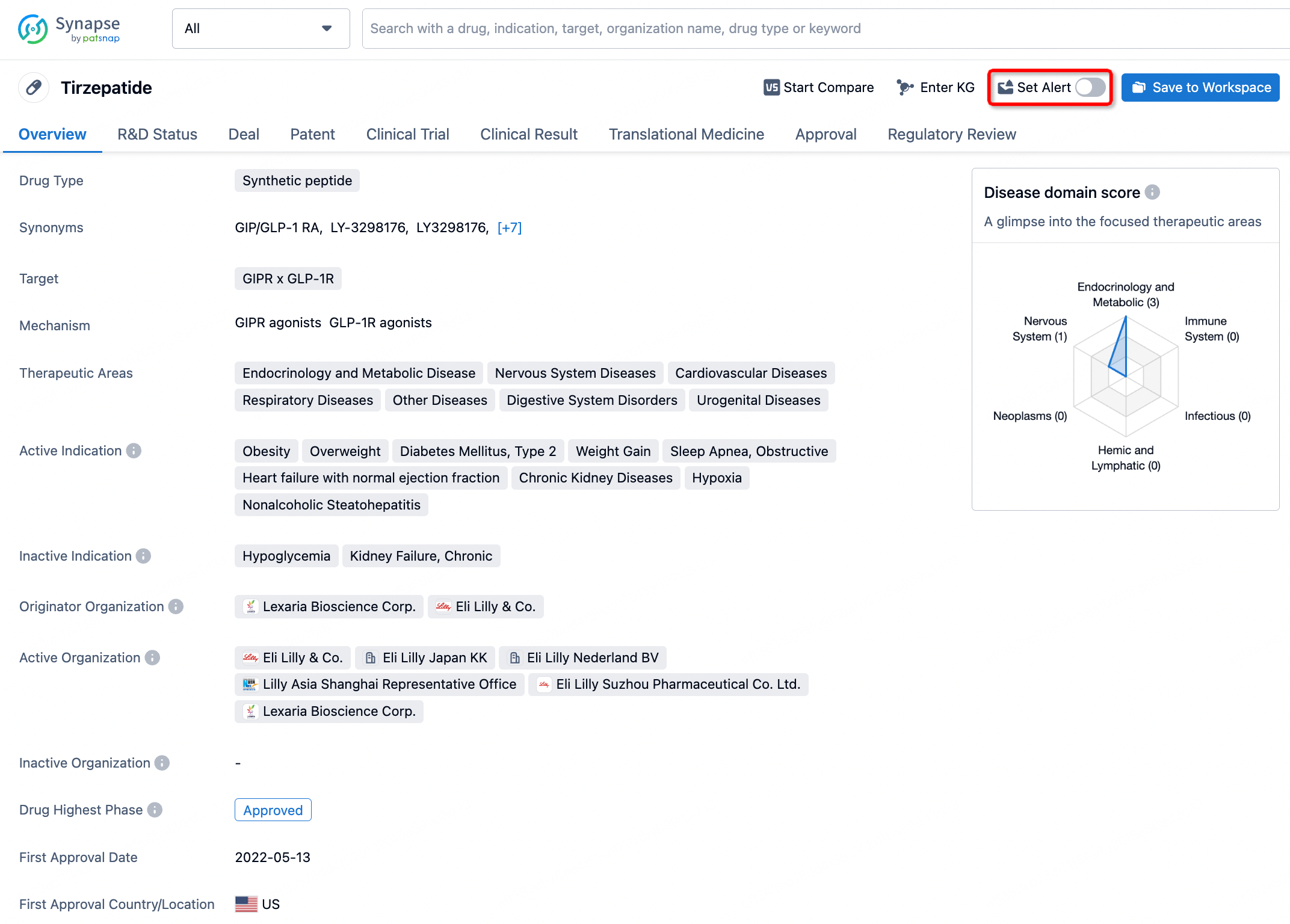Request Demo
What is Guaiazulene used for?
15 June 2024
In recent years, the skincare and pharmaceutical industries have seen a surge in interest around natural compounds, and one that has garnered particular attention is Guaiazulene. This fascinating compound, often found in chamomile oil and various medical formulations, has become popular for its soothing properties. Guaiazulene is recognized primarily under several trade names like Azulene, Azulon, and Azulen, among others. Various research institutions across the globe are investigating its potential, not only for its skin-caring attributes but also for more expansive therapeutic uses. This article delves into the intricacies of Guaiazulene, exploring its mechanism of action, usage, side effects, and interactions with other drugs.
Guaiazulene Mechanism of Action
Guaiazulene is a blue crystalline hydrocarbon that belongs to the class of azulenes, essentially a group of compounds known for their vibrant blue color. Structurally, Guaiazulene is similar to azulene but is derived from guaiac wood oil. The compound is mainly renowned for its anti-inflammatory and antioxidant properties, which play a significant role in its therapeutic effects.
At a molecular level, Guaiazulene operates by scavenging free radicals, thereby protecting cells from oxidative stress, one of the underlying factors in inflammation and cellular aging. Its anti-inflammatory action primarily involves the inhibition of cyclooxygenase (COX) enzymes, which are critical in the inflammatory pathway. By inhibiting these enzymes, Guaiazulene can reduce the formation of pro-inflammatory mediators like prostaglandins.
Furthermore, Guaiazulene also exhibits antimicrobial properties, making it effective against a range of bacteria and fungi. This multifaceted mechanism allows it to not only soothe inflamed skin but also tackle microbial infections that might exacerbate or trigger such conditions.
How to Use Guaiazulene
Guaiazulene is predominantly used in topical formulations, as its key applications involve skincare and wound healing. It is found in various over-the-counter and prescription products, including creams, ointments, and lotions. The standard concentration of Guaiazulene in these products typically ranges from 0.1% to 0.5%, depending on the intended use and the severity of the condition being treated.
For skincare purposes, Guaiazulene-containing products are usually applied to the affected area once or twice daily. The onset of action can vary; while some users may notice immediate soothing effects, the anti-inflammatory benefits typically become more pronounced after consistent use over several days to weeks.
In clinical settings, Guaiazulene can also be used as an adjunctive treatment for burns and other skin injuries. Here, its application might be more frequent initially, tapering off as the condition improves. It is crucial to follow the guidance of healthcare professionals when using Guaiazulene for medical purposes to ensure optimal results and avoid potential complications.
What are Guaiazulene Side Effects
As with any therapeutic agent, Guaiazulene isn’t without its side effects, although it is generally well-tolerated. The most common side effect reported is skin irritation, which may manifest as redness, itching, or a mild burning sensation at the site of application. This reaction is typically mild and subsides with continued use, but if it persists or worsens, discontinuation and consultation with a healthcare provider are advisable.
More severe allergic reactions, while rare, can occur and might present as rashes, swelling, or difficulty breathing. Such symptoms warrant immediate medical attention. It is also worth noting that individuals with known allergies to chamomile or other members of the Asteraceae family should exercise caution when using Guaiazulene, as they might be at higher risk for hypersensitivity reactions.
Contraindications for Guaiazulene use include severe skin conditions like eczema or psoriasis unless directed by a healthcare provider. Pregnant or breastfeeding women should consult their physician before starting any new topical treatment, including those containing Guaiazulene, to ensure it is safe for both mother and child.
What Other Drugs Will Affect Guaiazulene
Drug interactions with Guaiazulene are relatively uncommon, primarily because of its topical administration route, which limits systemic absorption and thus potential for systemic interactions. However, it is still important to be cautious, especially when using other topical agents concurrently. Combining Guaiazulene with other anti-inflammatory or antimicrobial agents may enhance its effects but could also increase the risk of skin irritation or allergic reactions.
Patients using prescription medications for skin conditions should inform their healthcare providers before starting Guaiazulene. Likewise, combining Guaiazulene with other over-the-counter topical treatments should be done carefully, ideally under the guidance of a healthcare professional, to prevent adverse interactions or diminished efficacy.
In conclusion, Guaiazulene represents a promising natural compound in the realm of skincare and beyond, thanks to its anti-inflammatory, antioxidant, and antimicrobial properties. While it is generally safe and effective, understanding its mechanism, proper usage, potential side effects, and interactions is essential for maximizing its benefits. As research progresses, we can expect to uncover even more about this intriguing compound, further cementing its place in both therapeutic and cosmetic applications.
Guaiazulene Mechanism of Action
Guaiazulene is a blue crystalline hydrocarbon that belongs to the class of azulenes, essentially a group of compounds known for their vibrant blue color. Structurally, Guaiazulene is similar to azulene but is derived from guaiac wood oil. The compound is mainly renowned for its anti-inflammatory and antioxidant properties, which play a significant role in its therapeutic effects.
At a molecular level, Guaiazulene operates by scavenging free radicals, thereby protecting cells from oxidative stress, one of the underlying factors in inflammation and cellular aging. Its anti-inflammatory action primarily involves the inhibition of cyclooxygenase (COX) enzymes, which are critical in the inflammatory pathway. By inhibiting these enzymes, Guaiazulene can reduce the formation of pro-inflammatory mediators like prostaglandins.
Furthermore, Guaiazulene also exhibits antimicrobial properties, making it effective against a range of bacteria and fungi. This multifaceted mechanism allows it to not only soothe inflamed skin but also tackle microbial infections that might exacerbate or trigger such conditions.
How to Use Guaiazulene
Guaiazulene is predominantly used in topical formulations, as its key applications involve skincare and wound healing. It is found in various over-the-counter and prescription products, including creams, ointments, and lotions. The standard concentration of Guaiazulene in these products typically ranges from 0.1% to 0.5%, depending on the intended use and the severity of the condition being treated.
For skincare purposes, Guaiazulene-containing products are usually applied to the affected area once or twice daily. The onset of action can vary; while some users may notice immediate soothing effects, the anti-inflammatory benefits typically become more pronounced after consistent use over several days to weeks.
In clinical settings, Guaiazulene can also be used as an adjunctive treatment for burns and other skin injuries. Here, its application might be more frequent initially, tapering off as the condition improves. It is crucial to follow the guidance of healthcare professionals when using Guaiazulene for medical purposes to ensure optimal results and avoid potential complications.
What are Guaiazulene Side Effects
As with any therapeutic agent, Guaiazulene isn’t without its side effects, although it is generally well-tolerated. The most common side effect reported is skin irritation, which may manifest as redness, itching, or a mild burning sensation at the site of application. This reaction is typically mild and subsides with continued use, but if it persists or worsens, discontinuation and consultation with a healthcare provider are advisable.
More severe allergic reactions, while rare, can occur and might present as rashes, swelling, or difficulty breathing. Such symptoms warrant immediate medical attention. It is also worth noting that individuals with known allergies to chamomile or other members of the Asteraceae family should exercise caution when using Guaiazulene, as they might be at higher risk for hypersensitivity reactions.
Contraindications for Guaiazulene use include severe skin conditions like eczema or psoriasis unless directed by a healthcare provider. Pregnant or breastfeeding women should consult their physician before starting any new topical treatment, including those containing Guaiazulene, to ensure it is safe for both mother and child.
What Other Drugs Will Affect Guaiazulene
Drug interactions with Guaiazulene are relatively uncommon, primarily because of its topical administration route, which limits systemic absorption and thus potential for systemic interactions. However, it is still important to be cautious, especially when using other topical agents concurrently. Combining Guaiazulene with other anti-inflammatory or antimicrobial agents may enhance its effects but could also increase the risk of skin irritation or allergic reactions.
Patients using prescription medications for skin conditions should inform their healthcare providers before starting Guaiazulene. Likewise, combining Guaiazulene with other over-the-counter topical treatments should be done carefully, ideally under the guidance of a healthcare professional, to prevent adverse interactions or diminished efficacy.
In conclusion, Guaiazulene represents a promising natural compound in the realm of skincare and beyond, thanks to its anti-inflammatory, antioxidant, and antimicrobial properties. While it is generally safe and effective, understanding its mechanism, proper usage, potential side effects, and interactions is essential for maximizing its benefits. As research progresses, we can expect to uncover even more about this intriguing compound, further cementing its place in both therapeutic and cosmetic applications.
How to obtain the latest development progress of all drugs?
In the Synapse database, you can stay updated on the latest research and development advances of all drugs. This service is accessible anytime and anywhere, with updates available daily or weekly. Use the "Set Alert" function to stay informed. Click on the image below to embark on a brand new journey of drug discovery!
AI Agents Built for Biopharma Breakthroughs
Accelerate discovery. Empower decisions. Transform outcomes.
Get started for free today!
Accelerate Strategic R&D decision making with Synapse, PatSnap’s AI-powered Connected Innovation Intelligence Platform Built for Life Sciences Professionals.
Start your data trial now!
Synapse data is also accessible to external entities via APIs or data packages. Empower better decisions with the latest in pharmaceutical intelligence.


